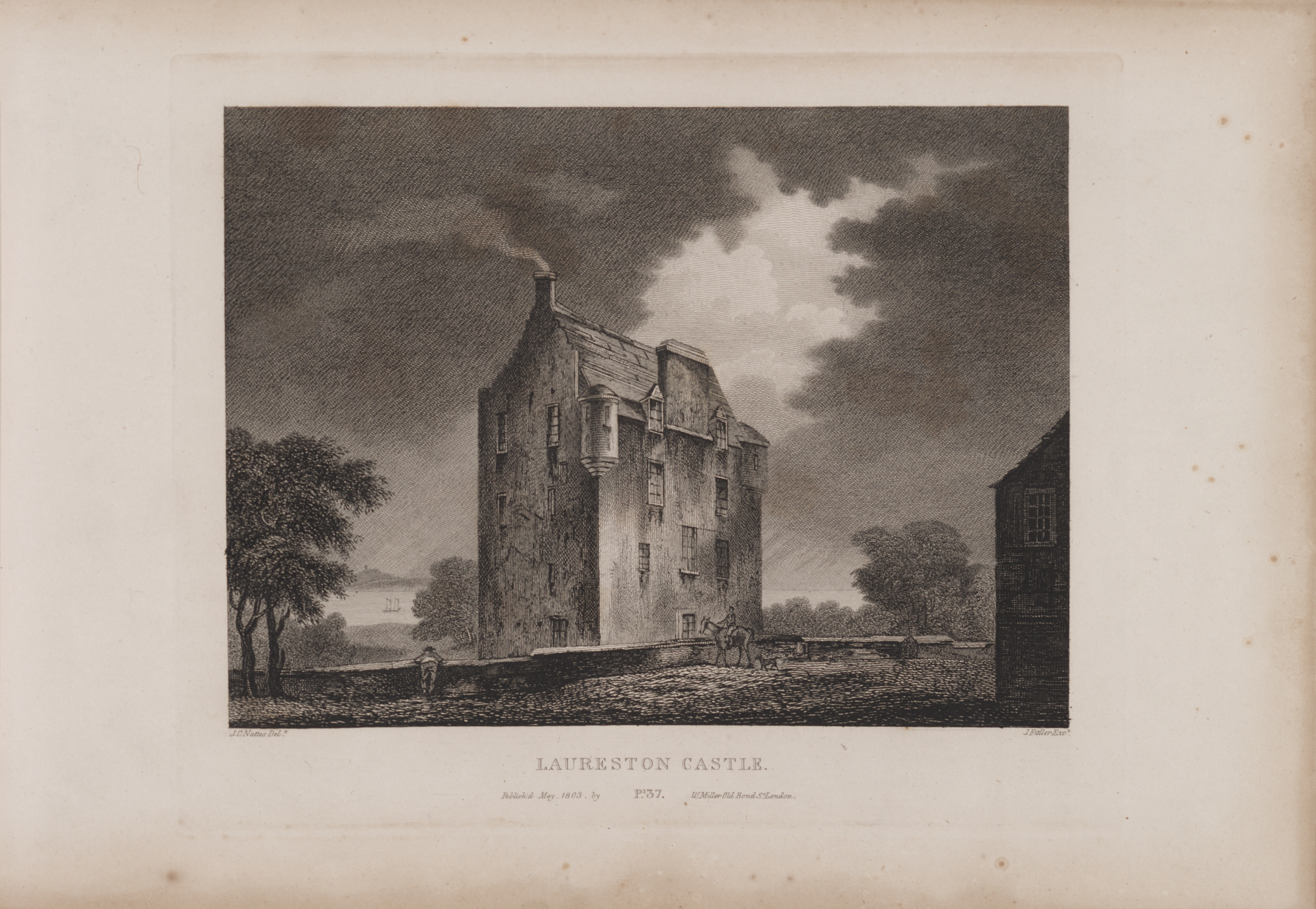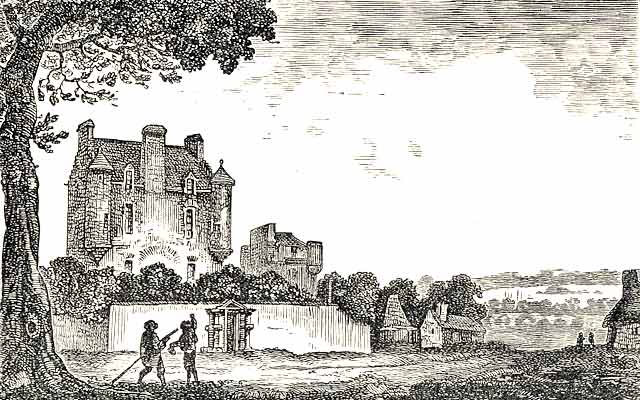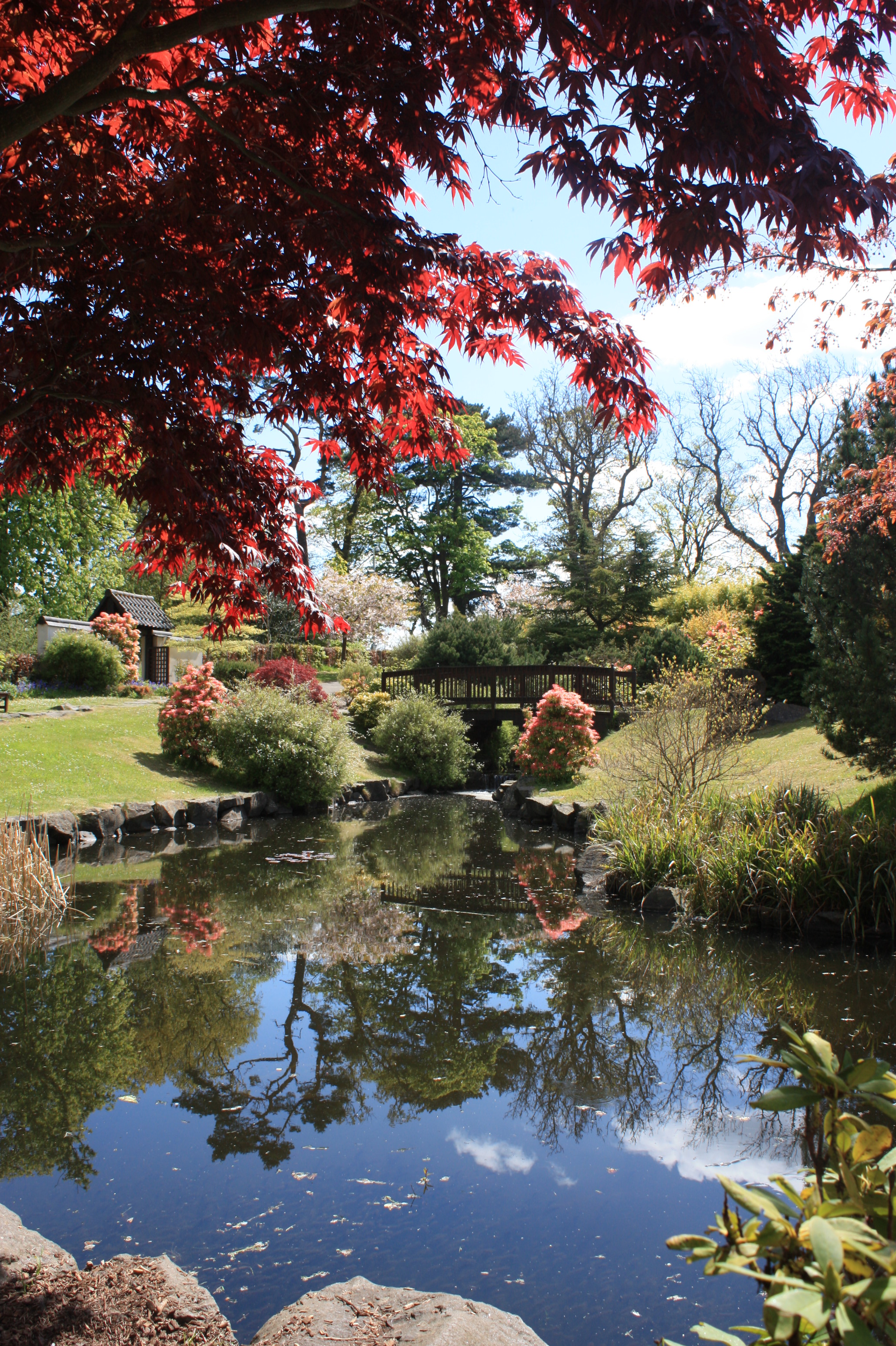Lauriston Castle on:
[Wikipedia]
[Google]
[Amazon]
Lauriston Castle is a 16th-century
 William Robert Reid, proprietor of Morison & Co., an Edinburgh cabinetmaking business, acquired Lauriston Castle in 1902, installed modern plumbing and electricity, and he and his wife Margaret filled the house with a collection of fine furniture and artwork. The Reids, being childless, left their home to Scotland on the condition that it should be preserved unchanged. The City of Edinburgh has administered the house since Mrs Reid's death in 1926, which today offers a glimpse of
William Robert Reid, proprietor of Morison & Co., an Edinburgh cabinetmaking business, acquired Lauriston Castle in 1902, installed modern plumbing and electricity, and he and his wife Margaret filled the house with a collection of fine furniture and artwork. The Reids, being childless, left their home to Scotland on the condition that it should be preserved unchanged. The City of Edinburgh has administered the house since Mrs Reid's death in 1926, which today offers a glimpse of
 Lauriston Castle was originally a four-storey, stone L plan tower house, with a circular stair tower, with two-storey angle turrets complete with gun loops. A Jacobean range was added in 1827, to convert it to a country manor. This was designed by the prominent architect
Lauriston Castle was originally a four-storey, stone L plan tower house, with a circular stair tower, with two-storey angle turrets complete with gun loops. A Jacobean range was added in 1827, to convert it to a country manor. This was designed by the prominent architect
 The extensive gardens at Lauriston are open to the public at no charge and include a number of different styles and forms. The most recent addition is a notable
The extensive gardens at Lauriston are open to the public at no charge and include a number of different styles and forms. The most recent addition is a notable
"Looking for ghosts? Try the usual haunts"
''The Supernatural World''
Description of Lauriston with photoLauriston Castle official websiteEdinburgh Croquet ClubFriendship Garden"Stravaiging Around Scotland: 'Lauriston Castle'"Engraving of Lauriston Castle
by
Scotia Depicta, or the antiquities, castles, public buildings, noblemen and gentlemen's seats, cities, towns and picturesque scenery of Scotland
1804 at
tower house
A tower house is a particular type of stone structure, built for defensive purposes as well as habitation. Tower houses began to appear in the Middle Ages, especially in mountainous or limited access areas, in order to command and defend strateg ...
with 19th-century extensions overlooking the Firth of Forth, in Edinburgh
Edinburgh ( ; gd, Dùn Èideann ) is the capital city of Scotland and one of its 32 Council areas of Scotland, council areas. Historically part of the county of Midlothian (interchangeably Edinburghshire before 1921), it is located in Lothian ...
, Scotland. It lies on Cramond Road South, between Cramond
Cramond Village (; gd, Cathair Amain) is a village and suburb in the north-west of Edinburgh, Scotland, at the mouth of the River Almond where it enters the Firth of Forth.
The Cramond area has evidence of Mesolithic, Bronze Age and Roman ac ...
, Davidson's Mains
Davidson's Mains is a former village and now a district in the north-west of Edinburgh, Scotland. It is adjacent to the districts of Barnton, Cramond, Silverknowes, Blackhall and Corbiehill/House O'Hill. It was absorbed into Edinburgh as par ...
, and Silverknowes
Silverknowes is a district of Edinburgh, Scotland. Silverknowes lies to the northwest of the city. The district contains over 2000 homes, ranging in size from bungalow to semi-detached housing, much of it built during the mid-twentieth centur ...
. The substantial grounds, Lauriston Castle Gardens, operate as a local park. The castle was bequeathed to the Edinburgh Corporation (post 1975 known as Edinburgh City Council) and hosts the Lord Provost's annual Garden Party. The house is a Category A listed building
In the United Kingdom, a listed building or listed structure is one that has been placed on one of the four statutory lists maintained by Historic England in England, Historic Environment Scotland in Scotland, in Wales, and the Northern Irel ...
and the grounds are included in the Inventory of Gardens and Designed Landscapes in Scotland
The ''Inventory of Gardens and Designed Landscapes in Scotland'' is a listing of gardens and designed landscapes of national artistic and/or historical significance, in Scotland. The Inventory was originally compiled in 1987, although it is a cont ...
.
History
A Lauriston Castle stood on this site in medieval times but was almost totally destroyed in the raids on Edinburgh in 1544 by theEarl of Hertford
Earl () is a rank of the nobility in the United Kingdom. The title originates in the Old English word ''eorl'', meaning "a man of noble birth or rank". The word is cognate with the Scandinavian form ''jarl'', and meant "chieftain", particular ...
's troops.
A tower house was rebuilt around 1590 by Sir Archibald Napier Archibald Napier may refer to:
* Sir Archibald Napier (landowner) (1534–1608), Scottish landowner and official, master of the Scottish mint and Laird of Merchiston
* Archibald Napier, 1st Lord Napier (c. 1576–1645)
* Archibald Napier, 2nd Lord ...
of Merchiston
Merchiston ( ) is a residential area around Merchiston Avenue in the south-west of Edinburgh, Scotland.
Location
Merchiston Avenue is 1.3 miles Southwest of the West End of Edinburgh's principal street, Princes Street. Other areas near Merchi ...
, father of John Napier
John Napier of Merchiston (; 1 February 1550 – 4 April 1617), nicknamed Marvellous Merchiston, was a Scottish landowner known as a mathematician, physicist, and astronomer. He was the 8th Laird of Merchiston. His Latinized name was Ioann ...
, for his first son by his second marriage, also named Archibald (1575–1600), known as Napier of Woolmet
Danderhall is a village in Midlothian, Scotland, just outside Edinburgh but inside the Edinburgh City Bypass.
Overview
The village includes a large amount of council housing — although much of this is now privately owned by the occupiers ...
. Logically, this would be no earlier than 1596, the age of legal majority then being 21. There is no evidence that he ever occupied Lauriston Castle, and he was murdered in 1600, returning to his home, Woolmet House, south of Edinburgh. It is likely that Lauriston was instead occupied by William Napier (c. 1577–1622), the second son of his second marriage. What is certain is that in 1622 the property was inherited by Alexander Napier (the third son of the second marriage) who four years later adopted the title "Lord Laurieston". Lord Laurieston died in 1629, but the house continued to be occupied by his widow and three young children.
In 1683, the estate was purchased by Edinburgh goldsmith and financier William Law, father of infamous economist John Law
John Law may refer to:
Arts and entertainment
* John Law (artist) (born 1958), American artist
* John Law (comics), comic-book character created by Will Eisner
* John Law (film director), Hong Kong film director
* John Law (musician) (born 1961) ...
(1671–1729), shortly before his death. John Law then inherited the estate and it stayed in the family until 1823 when sold to banker and mineralogist Thomas Allan. There is no evidence that the Law family ever resided at Lauriston during their 140 years of ownership. In 1827, Allan commissioned William Burn
William Burn (20 December 1789 – 15 February 1870) was a Scottish architect. He received major commissions from the age of 20 until his death at 81. He built in many styles and was a pioneer of the Scottish Baronial Revival,often referred ...
(1789–1870) to extend the house in the Jacobean style
The Jacobean style is the second phase of Renaissance architecture in England, following the Elizabethan style. It is named after King James VI and I, with whose reign (1603–1625 in England) it is associated. At the start of James' reign ther ...
. Subsequent owners were the Right Hon. Andrew Lord Rutherfurd (1791–1854), and Thomas Macknight Crawfurd of Cartsburn and Lauriston Castle, 8th Baron of Cartsburn from 1871 to 1902.
On 3 December 1827 Sir Walter Scott wrote in his journal: "Went with Tom Allan to see his building at Lauriston where he has good taste; supporting instead of tearing down or destroying the old Chateau which once belonged to the famous Mississippi Law. The additions are in very good taste and will make a most comfortable house."
 William Robert Reid, proprietor of Morison & Co., an Edinburgh cabinetmaking business, acquired Lauriston Castle in 1902, installed modern plumbing and electricity, and he and his wife Margaret filled the house with a collection of fine furniture and artwork. The Reids, being childless, left their home to Scotland on the condition that it should be preserved unchanged. The City of Edinburgh has administered the house since Mrs Reid's death in 1926, which today offers a glimpse of
William Robert Reid, proprietor of Morison & Co., an Edinburgh cabinetmaking business, acquired Lauriston Castle in 1902, installed modern plumbing and electricity, and he and his wife Margaret filled the house with a collection of fine furniture and artwork. The Reids, being childless, left their home to Scotland on the condition that it should be preserved unchanged. The City of Edinburgh has administered the house since Mrs Reid's death in 1926, which today offers a glimpse of Edwardian
The Edwardian era or Edwardian period of British history spanned the reign of King Edward VII, 1901 to 1910 and is sometimes extended to the start of the First World War. The death of Queen Victoria in January 1901 marked the end of the Victori ...
life in a Scottish country house. Lauriston Castle was bequeathed to the nation of Scotland in 1926 and is held in Trust by The City of Edinburgh Council. It holds many similarities with the Estate of John and Mabel Ringling, left to the State of Florida in 1926. In 1925, John Fairley, who was to become a Trustee of Lauriston Castle Estate and its first live onsite curator wrote a limited edition book, of 350 copies, entitled "Lauriston Castle" detailing the history of the Castle and Estate - the holy grail for Lauriston Castle enthusiasts.
In 1905, during one of its numerous refurbishments, a stone carving of an astrological
Astrology is a range of divinatory practices, recognized as pseudoscientific since the 18th century, that claim to discern information about human affairs and terrestrial events by studying the apparent positions of celestial objects. Dif ...
horoscope was installed in the outer wall, on the south-west corner. The horoscope was reputedly done by John Napier for his brother. It can be seen in some pictures on the front wall, beneath the leftmost stair tower, near the ground.
In 2013 it was suggested that the castle could be renovated and turned into an official residence for the Lord Provost of Edinburgh, but the proposal did not go ahead due to costs and other reasons.
Design
 Lauriston Castle was originally a four-storey, stone L plan tower house, with a circular stair tower, with two-storey angle turrets complete with gun loops. A Jacobean range was added in 1827, to convert it to a country manor. This was designed by the prominent architect
Lauriston Castle was originally a four-storey, stone L plan tower house, with a circular stair tower, with two-storey angle turrets complete with gun loops. A Jacobean range was added in 1827, to convert it to a country manor. This was designed by the prominent architect William Burn
William Burn (20 December 1789 – 15 February 1870) was a Scottish architect. He received major commissions from the age of 20 until his death at 81. He built in many styles and was a pioneer of the Scottish Baronial Revival,often referred ...
.
The majority of the interior is Edwardian.
Gardens
Japanese garden
are traditional gardens whose designs are accompanied by Japanese aesthetics and philosophical ideas, avoid artificial ornamentation, and highlight the natural landscape. Plants and worn, aged materials are generally used by Japanese garden desi ...
of one hectare. The garden, built by Takashi Sawano, and dedicated as the Edinburgh–Kyoto
Kyoto (; Japanese: , ''Kyōto'' ), officially , is the capital city of Kyoto Prefecture in Japan. Located in the Kansai region on the island of Honshu, Kyoto forms a part of the Keihanshin metropolitan area along with Osaka and Kobe. , the ci ...
Friendship Garden, opened in August 2002.
At the back of the castle, there are beautiful views of the Firth of Forth and beyond to Fife
Fife (, ; gd, Fìobha, ; sco, Fife) is a council area, historic county, registration county and lieutenancy area of Scotland. It is situated between the Firth of Tay and the Firth of Forth, with inland boundaries with Perth and Kinross (i ...
, which are enjoyed by members of the Edinburgh Croquet Club on the three croquet lawns laid out on the castle grounds between 1950 and 1955.
To the north-east, the gardens include some excellent mature examples of monkey puzzle trees (Araucaria araucana
''Araucaria araucana'' (commonly called the monkey puzzle tree, monkey tail tree, piñonero, pewen or Chilean pine) is an evergreen tree growing to a trunk diameter of 1–1.5 m (3–5 ft) and a height of 30–40 m (100–130 ft). ...
).
The site is also famed for its bluebell wood
A bluebell wood is a woodland that in springtime has a carpet of flowering bluebells ('' Hyacinthoides non-scripta'') underneath a newly forming leaf canopy. The thicker the summer canopy, the more the competitive ground-cover is suppressed, encou ...
but the size of this was much reduced by the formation of the Japanese Garden.
Ghost
Lauriston Castle, like many other Scottish castles, is reputedly haunted. It is said that the sound of ghostly footsteps can be heard.''The Supernatural World''
References
External links
Description of Lauriston with photo
by
James Fittler
James Fittler (October 1758, in London – 2 December 1835) was an English engraver of portraits and landscapes and an illustrator of books. He was appointed by King George III to be his marine engraver.
Life
Fittler was born in London in Octo ...
in the digitised copy oScotia Depicta, or the antiquities, castles, public buildings, noblemen and gentlemen's seats, cities, towns and picturesque scenery of Scotland
1804 at
National Library of Scotland
The National Library of Scotland (NLS) ( gd, Leabharlann Nàiseanta na h-Alba, sco, Naitional Leebrar o Scotland) is the legal deposit library of Scotland and is one of the country's National Collections. As one of the largest libraries in the ...
{{Parks and gardens in Edinburgh
Castles in Edinburgh
Houses in Edinburgh
Clan Napier
Inventory of Gardens and Designed Landscapes
Category A listed buildings in Edinburgh
Listed castles in Scotland
Japanese gardens
Gardens in Edinburgh
Parks and commons in Edinburgh
Historic house museums in Edinburgh
Reportedly haunted locations in Edinburgh
Tower houses in Scotland